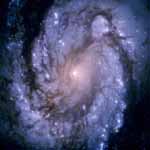
| 
| I. The Universe and the Solar System Were Suddenly Created.
The First Law of Thermodynamics states that the total quantity of matter and energy in the universe is constant. The Second Law of Thermodynamics states that matter and energy always tend to change from complex and ordered states to disordered states. Therefore the universe could not have created itself, but could not have existed forever, or it would have run down long ago. Thus the universe, including matter and energy, apparently must have been created.

The "big-bang" theory of the origin of the universe contradicts much physical evidence and seemingly can only be accepted by faith.[1]This was also the case with the past cosmogonic theories of evolutionists that have been discarded, such as Hoyle's steady-state theory.

The universe has "obvious manifestations of an ordered, structured plan or design." Similarly, "the electron is materially inconceivable and yet it is so perfectly known through its effects," yet a "strange rationale makes some physicists accept the inconceivable electrons as real while refusing to accept the reality of a Designer." "The inconceivability of some ultimate issue (which will always lie outside scientific resolution) should not be allowed to rule out any theory that explains the interrelationship of observed data and is useful for prediction," in the words of Dr. Warner von Braun, the renowned late physicist in the NASA space program.
|

